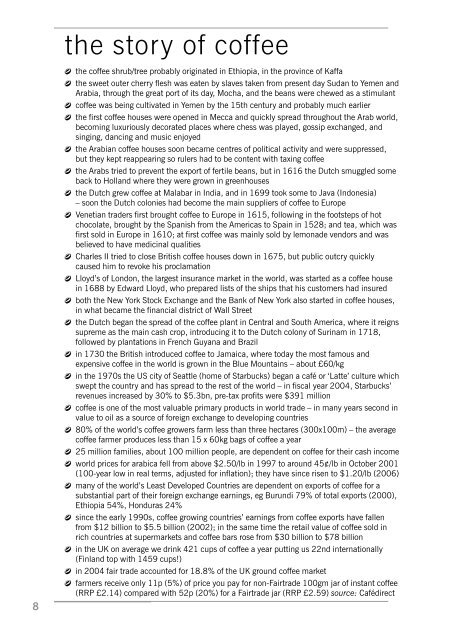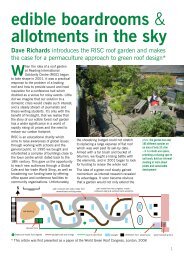Cost of coffee.indd - RISC
Cost of coffee.indd - RISC
Cost of coffee.indd - RISC
Create successful ePaper yourself
Turn your PDF publications into a flip-book with our unique Google optimized e-Paper software.
8<br />
the story <strong>of</strong> c<strong>of</strong>fee<br />
D the c<strong>of</strong>fee shrub/tree probably originated in Ethiopia, in the province <strong>of</strong> Kaffa<br />
D the sweet outer cherry flesh was eaten by slaves taken from present day Sudan to Yemen and<br />
Arabia, through the great port <strong>of</strong> its day, Mocha, and the beans were chewed as a stimulant<br />
D c<strong>of</strong>fee was being cultivated in Yemen by the 15th century and probably much earlier<br />
D the first c<strong>of</strong>fee houses were opened in Mecca and quickly spread throughout the Arab world,<br />
becoming luxuriously decorated places where chess was played, gossip exchanged, and<br />
singing, dancing and music enjoyed<br />
D the Arabian c<strong>of</strong>fee houses soon became centres <strong>of</strong> political activity and were suppressed,<br />
but they kept reappearing so rulers had to be content with taxing c<strong>of</strong>fee<br />
D the Arabs tried to prevent the export <strong>of</strong> fertile beans, but in 1616 the Dutch smuggled some<br />
back to Holland where they were grown in greenhouses<br />
D the Dutch grew c<strong>of</strong>fee at Malabar in India, and in 1699 took some to Java (Indonesia)<br />
– soon the Dutch colonies had become the main suppliers <strong>of</strong> c<strong>of</strong>fee to Europe<br />
D Venetian traders first brought c<strong>of</strong>fee to Europe in 1615, following in the footsteps <strong>of</strong> hot<br />
chocolate, brought by the Spanish from the Americas to Spain in 1528; and tea, which was<br />
first sold in Europe in 1610; at first c<strong>of</strong>fee was mainly sold by lemonade vendors and was<br />
believed to have medicinal qualities<br />
D Charles II tried to close British c<strong>of</strong>fee houses down in 1675, but public outcry quickly<br />
caused him to revoke his proclamation<br />
D Lloyd’s <strong>of</strong> London, the largest insurance market in the world, was started as a c<strong>of</strong>fee house<br />
in 1688 by Edward Lloyd, who prepared lists <strong>of</strong> the ships that his customers had insured<br />
D both the New York Stock Exchange and the Bank <strong>of</strong> New York also started in c<strong>of</strong>fee houses,<br />
in what became the financial district <strong>of</strong> Wall Street<br />
D the Dutch began the spread <strong>of</strong> the c<strong>of</strong>fee plant in Central and South America, where it reigns<br />
supreme as the main cash crop, introducing it to the Dutch colony <strong>of</strong> Surinam in 1718,<br />
followed by plantations in French Guyana and Brazil<br />
D in 1730 the British introduced c<strong>of</strong>fee to Jamaica, where today the most famous and<br />
expensive c<strong>of</strong>fee in the world is grown in the Blue Mountains – about £60/kg<br />
D in the 1970s the US city <strong>of</strong> Seattle (home <strong>of</strong> Starbucks) began a café or ‘Latte’ culture which<br />
swept the country and has spread to the rest <strong>of</strong> the world – in fiscal year 2004, Starbucks’<br />
revenues increased by 30% to $5.3bn, pre-tax pr<strong>of</strong>its were $391 million<br />
D c<strong>of</strong>fee is one <strong>of</strong> the most valuable primary products in world trade – in many years second in<br />
value to oil as a source <strong>of</strong> foreign exchange to developing countries<br />
D 80% <strong>of</strong> the world’s c<strong>of</strong>fee growers farm less than three hectares (300x100m) – the average<br />
c<strong>of</strong>fee farmer produces less than 15 x 60kg bags <strong>of</strong> c<strong>of</strong>fee a year<br />
D 25 million families, about 100 million people, are dependent on c<strong>of</strong>fee for their cash income<br />
D world prices for arabica fell from above $2.50/lb in 1997 to around 45¢/lb in October 2001<br />
(100-year low in real terms, adjusted for inflation); they have since risen to $1.20/lb (2006)<br />
D many <strong>of</strong> the world’s Least Developed Countries are dependent on exports <strong>of</strong> c<strong>of</strong>fee for a<br />
substantial part <strong>of</strong> their foreign exchange earnings, eg Burundi 79% <strong>of</strong> total exports (2000),<br />
Ethiopia 54%, Honduras 24%<br />
D since the early 1990s, c<strong>of</strong>fee growing countries’ earnings from c<strong>of</strong>fee exports have fallen<br />
from $12 billion to $5.5 billion (2002); in the same time the retail value <strong>of</strong> c<strong>of</strong>fee sold in<br />
rich countries at supermarkets and c<strong>of</strong>fee bars rose from $30 billion to $78 billion<br />
D in the UK on average we drink 421 cups <strong>of</strong> c<strong>of</strong>fee a year putting us 22nd internationally<br />
(Finland top with 1459 cups!)<br />
D in 2004 fair trade accounted for 18.8% <strong>of</strong> the UK ground c<strong>of</strong>fee market<br />
D farmers receive only 11p (5%) <strong>of</strong> price you pay for non-Fairtrade 100gm jar <strong>of</strong> instant c<strong>of</strong>fee<br />
(RRP £2.14) compared with 52p (20%) for a Fairtrade jar (RRP £2.59) source: Cafédirect




